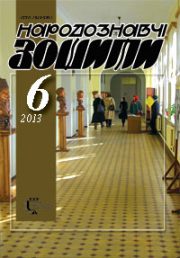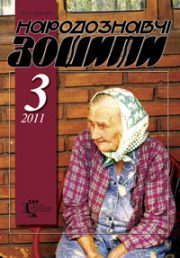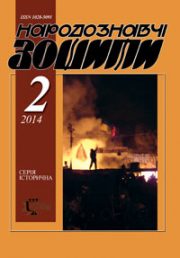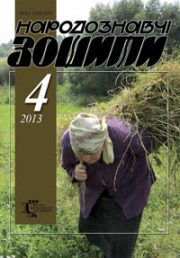The Ethnology Notebooks. 2019, № 5 (149), 1239—1245
UDK 811.161.2’373.21
DOI https://doi.org/10.15407/nz2019.05.1239
MOSUR Oksana
ORCID: https://orcid.org/0000-0003-1912-3580
Assistant of the Department of Ukrainian Language,
Lviv Ivan Franko National University
1, Universytets’ka str., L’viv, 79000, Ukraine
e-mail: oksana_kunanets@ukr.net
Abstract. Introduction: Historical microtoponymy is a valuable material of linguistic studies. Josyphinska (1785—1788) and Francyscanska (1819—1820) metrics are analyzed as a source of research of microtoponymy of Sambirskyycyrkul. Problem statement: The comprehensive analysis of peculiarities of Ukrainian historical microtoponymy is not elucidated enough in scientific works. The purpose of the article is to outline themeaning and features of the concept of «microtoponym». The main scientific methods in the article are descriptive one and text analysis. Results: The article outlines the meaning and peculiarities of the concept of «microtoponym», describes a number of factors that are decisive for the selection of the list of geographical objects, which names should be considered as microtoponyms. It is separated lingual and extra lingual features of microtoponymy. The first ones are: 1) close connection with appellatives — geographical names (nomenclature names) and toponyms; 2) dialectisms and foreign words as creative basis of onyms; 3) connection with anthroponyms; 4) a large number of names-landmarks; 5) variety of word-formation affixes; 6) using of toponymic metonymy and toponymic metaphor in microtoponymy; 7) using of names in microtoponomy in a figurative sense. Extra lingual peculiarities are: 1) limited circle of people and the territory where the proper name of geographical microobject is known; 2) relatively short lifetime of onym; 3) instability of the microtoponymic system, its variability, ability of replacement, updating and replenishment by new proper names which depend on socio-historical, cultural, physical-geographical changes; 4) dependence of the name on the features and characteristics of the object. Conclusion: Historical microtoponymy is an important layer of proper names. It combines lingual and extra lingual features, and depends on different factors of people life and society development.
Keywords: microtoponym, microtoponymy, Sambirskyycyrkul, Josyphinska (1785—1788) metric, Francyscanska (1819—1820) metric.
Received 24.09.2019
REFERENCES
Nikonov,V.A. (1964). The scientific value of microtoponymy. Microtoponymy. Proceedings of the conference. Moscow [in Russian].
Zakharchyshyna, Ja (Ed.). (1965). Josyphinska (1785—1788) and Francyscanska (1819—1820) metrics. First land cadasters of Galicia. Index of settlements. Kyiv: Naukova dumka [in Ukrainian].
Veryga, V. (1996). Essays from the history of Ukraine (the end of ХVIII — the beginning of ХІХ сc.). Lviv: Svit [in Ukrainian].
Chekhovskyy, I.G. (1996). Microtoponymy of Chernivtsi region (creations on the basis of geographical terminology. (Cand. hist. sci. diss. abstr.). Chernivtsi [in Ukrainian].
Vasylyk, O.B. (2015). Microtoponymy of Umanshchyna of XVII—XIX cc. (Cand. philol. sci. diss. abstr.). Vinnytsia [in Ukrainian].
Sokil, N.V. (2008). Microtoponymy of Skolivshchyna. Lviv: Lviv Ivan Franko National University [in Ukrainian].
Banioi, V.F. (2009). Microtoponyms of the basin of the River Uzh (on the material of Transcarpathian Ukrainian dialects). (Cand. philol. sci. diss. abstr.). Ivano-Frankivsk [in Ukrainian].
Bilinska, L.P. (2012). The formation of the microtoponymy of Pokuttia. (Cand. philol. sci. diss. abstr.). Ivano-Frankivsk [in Ukrainian].
Luzhetska, O.B. (2015). Microtoponymy of South-Western Opillia. (Cand. philol. sci. diss. abstr.). Ivano-Frankivsk [in Ukrainian].
Superanskaya, A.V. (1967). Microtoponymy, macrotoponymy and its difference from toponymy. Microtoponymy. Moscow [in Russian].
Superanskaya, A.V. (1964). Microtoponymy, macrotoponymy and its difference from toponymy. Microtoponymy. Proceedings of the conference. Moscow [in Russian].
Nikonov, V.A. (1967). The scientific value of microtoponymy. Microtoponymy. Moscow [in Russian].
Buckko, D.G., & Tkachova, N.V. (Eds.). (2012). Dictionary of Ukrainian onomastic terminology. Kharkiv: Ranok-NT [in Ukrainian].
Zhetelska-Feleshko, E., & Cieslikowa, A. (Eds.). (2003). Slavic onomastics: Encyclopedia (Vol. 2). Warsaw; Krakow: Tow. Naukowe Warshawskie [in Polish].
Podolskaya, N.V. (1965). The problems of microtoponymy studies. The problems of onomastics: Proceedings of the Second Republican Conference on Onomastics. Lviv [in Russian].
Karpenko, Yu.A. (1967). Properties and sources of microtoponymy. Microtoponymy (Pp, 15—22) [in Russian].
Pospelov, E.M. (1967). Geographical terminology in Carpathian microtoponymy. Microtoponymy (Pp. 23—30) [in Russian].
CSHAL (Central State Historical Archive of Lviv). F. 19. Op. 14. Od. save. 354. Arc. 1—246 [in Ukrainian].
CSHAL (Central State Historical Archive of Lviv). F. 19. Op. 14. Od. save 48. Arc. 1—367 [in Ukrainian].
Boldyrev, R.V. (Ed.) (1982). Etymological dictionary of Ukrainian Language (Vol. 1). Kyiv: Naukovadumka [in Ukrainain].
Onyshkevych, M.Y. (1984). Dictionary of boykivskyy dialect. (Vol. 1). Kyiv: Naukovadumka [in Ukrainian].
CSHAL (Central State Historical Archive of Lviv). F. 19. Op. 14. Od. save 161. Arc. 1—92 [in Ukrainian].
Rudnicki, J. (1939). Geographical names of Boykivshchyna. Lviv [in Polish].
CSHAL (Central State Historical Archive of Lviv). F. 19. Op. 14. Od. save 150. Arc. 1—40 [in Ukrainian].
Buriachok, A.A., & Dotsenko, P.P. (Eds.) (1973). Dictionary of Ukrainian Language (Vol. 4). Kyiv: Naukova dumka [in Ukrainian].
CSHAL (Central State Historical Archive of Lviv). F. 19. Op. 14. Od. save 164. Arc. 1—169 [in Ukrainian].
CSHAL (Central State Historical Archive of Lviv). F. 19. Op. 14. Od. save 54. Arc. 1—114 [in Ukrainian].
Prots’,O.I. (2011). Microtoponymy of the north districts of Lviv region. (Cand. philol. sci. diss. abstr.). Lviv[in Ukrainian].
Koperskiy, S.A. (1966). Essays from toponymy. Onomastics. The magazine devoted to geographical names and anthroponyms, 1—2, 93—107 [in Russian].
CSHAL (Central State Historical Archive of Lviv). F. 19. Op. 14. Od. save 71. Arc. 1—159 [in Ukrainian].
CSHAL (Central State Historical Archive of Lviv). F. 19. Op. 14. Od. save 40. Arc. 1—183 [in Ukrainian].
CSHAL (Central State Historical Archive of Lviv). F. 19. Op. 14. Od. save 268. Arc. 1—94 [in Ukrainian].
CSHAL (Central State Historical Archive of Lviv). F. 19. Op. 14. Od. save 300. Arc. 1—66 [in Ukrainian].
CSHAL (Central State Historical Archive of Lviv). F. 20. Op. 14. Od. save 49. Arc. 1—62 [in Ukrainian].
CSHAL (Central State Historical Archive of Lviv). F. 19. Op. 14. Od. save 303. Arc. 1—75 [in Ukrainian].
CSHAL (Central State Historical Archive of Lviv). F. 20. Op. 14. Od. save 177. Arc. 1—56 [in Ukrainian].
CSHAL (Central State Historical Archive of Lviv). F. 19. Op. 14. Od. save 289. Arc. 1—372 [in Ukrainian].
CSHAL (Central State Historical Archive of Lviv). F. 20. Op. 14. Od. save 241. Arc. 1—384 [in Ukrainian].
Gumetska, L.L. (1962). About name Gostiatain Novgorod birch document. ІІ Republican Onomastic Conference: proceedings, 9, 165—166[in Ukrainian].
Gumetska, L.L. (1962). Onomastic formant -yat in Ukrainian language. Slavic linguistics, 4, 17—32 [in Ukrainian].
CSHAL (Central State Historical Archive of Lviv). F. 19. Op. 14. Od. save 162. Arc. 1—139 [in Ukrainian].







